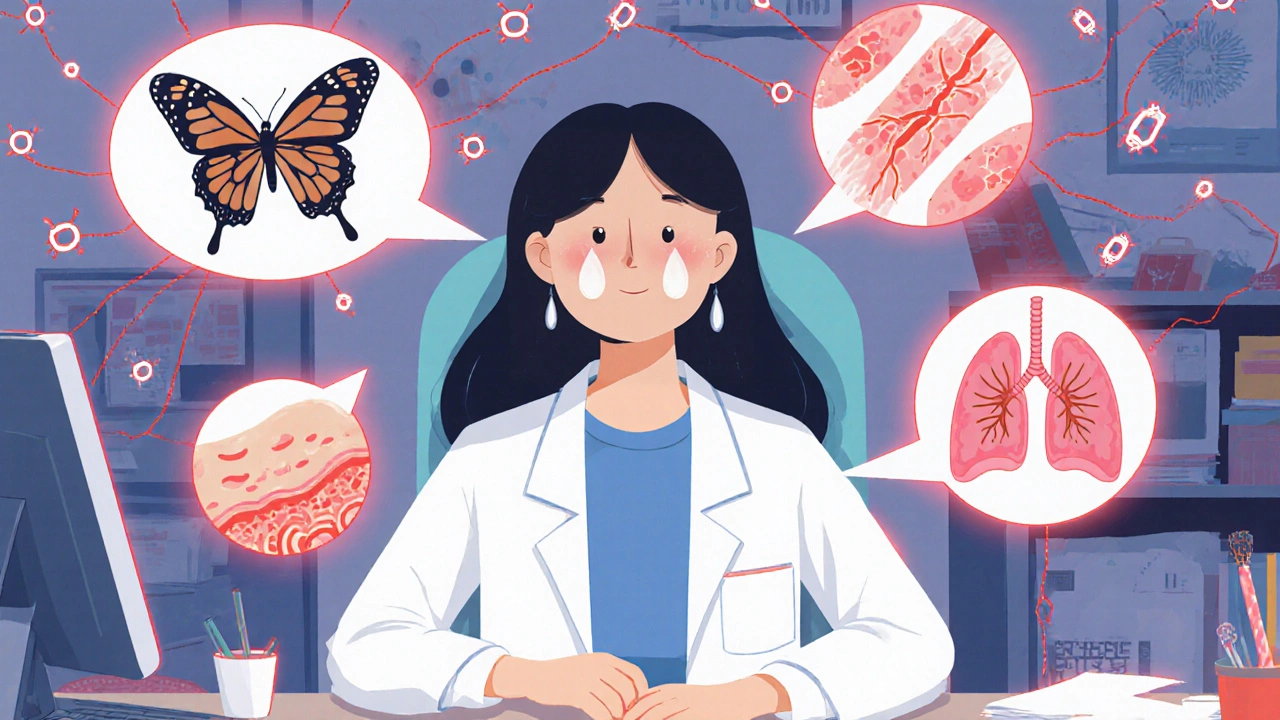Imagine being told you have lupus, then months later your doctor says, "Actually, you also have scleroderma." Then your lungs start acting up, and your muscles ache like you’ve run a marathon without training. You’re not just dealing with one autoimmune disease-you’re juggling three, maybe four. This isn’t rare. In fact, autoimmune overlap syndromes affect up to 25% of people with a connective tissue disease within five to ten years of their first diagnosis.
What Exactly Are Autoimmune Overlap Syndromes?
Autoimmune overlap syndromes happen when a person shows clear signs of two or more distinct autoimmune diseases at the same time. These aren’t random combinations. They follow recognizable patterns. The most common are mixed connective tissue disease (MCTD), antisynthetase syndrome, and polymyositis/scleroderma (PM/Scl) overlap.MCTD is defined by one key blood marker: high-titer anti-U1-RNP antibodies-often over 1:10,000. People with MCTD usually have puffy hands, Raynaud’s phenomenon (fingers turning white or blue in the cold), swollen joints, and muscle weakness. It’s like a blend of lupus, scleroderma, and arthritis, but with its own fingerprint in the blood.
Antisynthetase syndrome is trickier. It’s tied to antibodies against enzymes called aminoacyl-tRNA synthetases, especially anti-Jo-1. The classic triad? Muscle inflammation (myositis), lung scarring (interstitial lung disease), and mechanic’s hands-cracked, dirty-looking skin on the fingers. About 70% of these patients develop serious lung problems, sometimes before muscle symptoms even show up.
PM/Scl overlap is another common mix. Patients have skin thickening like scleroderma, plus muscle weakness like polymyositis. The anti-PM/Scl antibody is rare-found in only 2-5% of scleroderma patients-but when it’s there, it’s a clear signal. These patients often need lung scans early, because nearly half develop interstitial lung disease.
Then there’s Multiple Autoimmune Syndrome (MAS), where three or more autoimmune diseases cluster together. Type 2 MAS, for example, might include Sjögren’s, rheumatoid arthritis, and thyroid disease. It’s not just a coincidence. The immune system is firing on multiple fronts, and the body pays the price.
Why Diagnosis Is So Hard
There’s no official checklist for overlap syndromes. The American College of Rheumatology and EULAR have clear rules for lupus, scleroderma, or myositis individually-but not when they mix. That’s why so many patients get stuck in diagnostic limbo.A 2022 study found that 45% of people with overlap syndromes waited more than 18 months for a correct diagnosis. Compare that to 12 months for a single autoimmune disease. Why the delay? Because symptoms bleed into each other. Fatigue? Could be lupus. Dry eyes? Sjögren’s. Tight skin? Scleroderma. But if you don’t have all the classic signs for any one disease, doctors hesitate.
One patient on Reddit described seeing seven specialists before someone connected the dots. "I had symptoms of both scleroderma and polymyositis, but didn’t fully meet criteria for either," she wrote. "So they treated me for one while ignoring the other."
Autoantibodies are the key. Anti-U1-RNP for MCTD, anti-Jo-1 for antisynthetase, anti-PM/Scl for the muscle-skin combo. These aren’t just lab curiosities-they’re diagnostic anchors. But even then, some overlap cases don’t have clear markers. That’s where clinical judgment becomes critical.
What Happens When No One Coordinates Your Care
This is where things fall apart. Most patients see a rheumatologist for their lupus, a pulmonologist for lung scarring, a dermatologist for skin changes, and a physical therapist for muscle weakness. But who’s watching the big picture?A 2022 survey by the Sjögren’s Foundation found that 68% of patients with Sjögren’s-lupus overlap struggled to get coordinated care. Only 32% said their doctors talked to each other. That’s not just inconvenient-it’s dangerous.
Imagine you’re on prednisone for joint pain, but your lung specialist adds mycophenolate for scarring. Then your dermatologist prescribes a topical steroid. Without coordination, you’re on three immunosuppressants. That raises your risk of serious infections. One study showed 28% of patients on triple therapy developed pneumonia or other infections, compared to just 15% on dual therapy.
At the Cleveland Clinic’s Overlap Syndrome Program, they assigned a single care coordinator to manage appointments, meds, and communication between specialists. The result? Hospitalizations dropped by 35%, and medication adherence jumped 42%. It’s not magic-it’s structure.

How Treatment Is Changing
Treatment used to be a shotgun approach: high-dose steroids plus one or two immunosuppressants and hope for the best. Now, it’s more targeted.For most overlap cases, doctors start with prednisone (0.5-1 mg per kg of body weight) and one disease-modifying drug-usually methotrexate or mycophenolate. But if lung disease is the main problem, things change. In 2023, the FDA approved tocilizumab for antisynthetase syndrome with interstitial lung disease. In clinical trials, it cut disease progression by 55% compared to placebo.
Rituximab, a B-cell blocker, is also showing promise in stubborn cases. Studies report 60-70% stabilization or improvement in lung function after 12 months. But it’s not for everyone. Some patients with MCTD or lupus components can flare if B-cells are wiped out too aggressively.
Doctors now aim for specific targets: keep lung function above 80% of predicted, keep skin thickening under a Rodnan score of 15, and maintain minimal disease activity in joints. It’s not about suppressing everything-it’s about controlling the most dangerous parts.
The Future: AI, Biomarkers, and Better Tools
The field is moving fast. In January 2023, the NIH launched a $15 million project to find biomarkers that predict who will develop overlap syndromes-and which treatments will work best for them.Meanwhile, AI is stepping in. A 2022 study in Nature Medicine trained an algorithm to scan electronic health records. It could predict overlap syndrome development 12 months before a doctor noticed symptoms-with 82% accuracy. That’s huge. Early detection means early intervention.
There’s also a new trial underway for anifrolumab, a drug already approved for lupus, being tested specifically for MCTD. Results are expected by the end of 2024. If it works, it could become the first drug approved specifically for overlap syndrome.
And the tools are getting smarter. Researchers are building composite scores that track skin tightness, muscle strength, joint pain, and lung function all in one number. No more piecing together reports from five different specialists. One dashboard. One plan.

What Patients Need to Know
If you’re dealing with multiple autoimmune symptoms, don’t accept "we don’t know" as an answer. Ask for autoantibody testing. Push for a pulmonary function test and high-resolution CT scan of your lungs-even if you’re not short of breath. Interstitial lung disease can be silent until it’s advanced.Find a center that specializes in complex autoimmune cases. Johns Hopkins, Mayo Clinic, and Hospital for Special Surgery have dedicated overlap syndrome clinics. They don’t just treat diseases-they coordinate care.
Keep a symptom log. Note when your fingers turn blue, when your muscles feel weak, when your skin tightens. Bring it to every appointment. Doctors miss things when symptoms are scattered across months.
And don’t be afraid to ask: "Who’s managing my overall treatment?" If no one is, insist on a care coordinator. Your life depends on it.
Why This Matters
Autoimmune overlap syndromes aren’t rare. They’re underdiagnosed. And they’re growing. The global autoimmune market hit $126.5 billion in 2022, with overlap cases making up 15-20% of rheumatology referrals. More research, more funding, more awareness-it’s happening.But progress won’t come from better drugs alone. It will come from better systems. From doctors talking to each other. From patients being heard. From care that sees the whole person, not just the next lab result.
If you’re living with multiple autoimmune conditions, you’re not alone. But you shouldn’t have to fight the system alone, either. The tools are there. The knowledge is growing. What’s missing is the coordination. And that’s something you can change.


Jessica Healey
November 17, 2025 AT 02:25So I got diagnosed with lupus last year and now my hands are turning purple in the AC? I thought it was just bad circulation. Turns out I’ve had Raynaud’s for years and no one connected it. Now I’m terrified I’m gonna wake up with skin like a prune. Anyone else feel like your body is staging a coup?
Also why does every doctor act like I’m making this up? I’m not a walking symptom bingo card.
Levi Hobbs
November 17, 2025 AT 10:43I just want to say-this is one of the most thorough, compassionate, and clinically accurate pieces I’ve read on this topic. The part about care coordination? So true. My rheumatologist and pulmonologist didn’t speak for 14 months. I had to print out my labs, draw arrows, and hand them a flowchart. It’s absurd that we’re expected to be our own case managers.
Also, the 35% hospitalization drop at Cleveland Clinic? That’s not a stat-that’s a revolution. We need this model everywhere. Please, someone, fund this.
henry mariono
November 17, 2025 AT 16:24I’m not a doctor, but I’ve watched my mom go through this. She had Sjögren’s, then RA, then thyroiditis. They treated each thing like a separate problem. She ended up on six meds, all interacting, all making her dizzy. No one ever sat down and said, ‘What’s the priority?’
I just wanted to say thank you for writing this. It’s the first time I felt like someone actually saw her.
shubham seth
November 18, 2025 AT 11:57Let me guess-Big Pharma is selling you this ‘overlap syndrome’ nonsense to upsell you three different biologics at once. You think they care about your lungs? Nah. They care about your insurance card. Tocilizumab costs $20k a month. Who’s paying? You? Your employer? The government? All of us.
And don’t even get me started on AI predicting your disease before you feel it. That’s not medicine-that’s surveillance with a stethoscope. Next they’ll microchip your blood cells.
kora ortiz
November 20, 2025 AT 08:43STOP WAITING. Go get that CT scan. Now. Don’t wait for symptoms. Don’t wait for your doctor to ‘think of it.’ You are your own best advocate. I was told my lung scarring was ‘just allergies.’ Two years later, I was on oxygen. Don’t be me.
Find a specialist. Bring your log. Demand coordination. You deserve care that sees you-not just your lab numbers. You got this.
Jeremy Hernandez
November 20, 2025 AT 22:12Autoimmune overlap? More like autoimmune scam. You’re all just hypochondriacs who Google too hard. I’ve seen people think they have 7 diseases because they had a headache and a rash. The system is broken? Nah. You’re broken. Stop buying into this medical theater.
Also, AI predicting disease? Next they’ll tell you you’re gonna die on Tuesday. I’m out.
Tarryne Rolle
November 22, 2025 AT 16:41If your immune system is ‘firing on multiple fronts,’ then perhaps it’s not malfunctioning-it’s awakening. Maybe the body isn’t attacking itself… maybe it’s rejecting the artificial reality we’ve built. Glyphosate. Vaccines. EMF. Fluoride. We’ve poisoned the well, and now the immune system is screaming.
Why treat the symptom when the cause is systemic collapse? You don’t need a care coordinator-you need a reset.
Kyle Swatt
November 24, 2025 AT 12:58I used to think autoimmune diseases were just broken switches in the body. Now I think they’re the body’s last cry for attention. We live in a world that rewards burnout, ignores fatigue, and medicates grief. Maybe the immune system isn’t wrong-it’s the only thing still trying to say, ‘Something’s off here.’
That’s why coordination matters. Not just for meds, but for humanity. We need people who see the whole person, not just the broken parts.
Also, I cried reading the Cleveland Clinic part. That’s not medicine. That’s love in a lab coat.
Deb McLachlin
November 25, 2025 AT 18:39Thank you for this comprehensive overview. I would be interested to know whether any longitudinal studies have been conducted on the progression of overlap syndromes in patients who received coordinated care versus those who did not. Additionally, are there any validated patient-reported outcome measures specific to multi-disease autoimmune conditions? The absence of such tools may significantly impede clinical trials and treatment optimization.